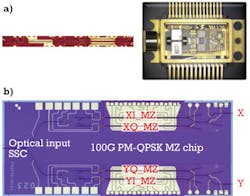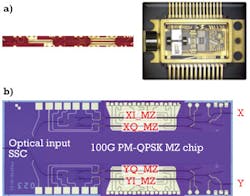New era in optical-fiber cabling
Combining low loss with the right amount of bend tolerance in the same fiber significantly simplifies network plant engineering.
By Dr. Merrion Edwards
Optical fiber is the foundation of the modern communications network, providing the data capacity and speed that enable all of our latest communication devices and services. As we demand more of our networks, we demand more of our fiber: more capacity, more speed, and more deployment adaptability. With the relentless rise in capacity demand and relatively flat telecom revenues, operators require more capex-efficient networks with low operations, administration, and maintenance (OAM) cost to support viable telecom return on investment (ROI).
To this end, carriers have adopted Optical Transport Network (OTN) approaches that enable different service types (for example, SONET/SDH, Ethernet, Fibre Channel, and storage services) to coexist within the same transport layer. Such protocol transport commonality and service transparency offer tremendous capex and OAM benefits to the carrier, which ultimately lower the cost per bit.
Similarly, carriers are looking to the systems vendors to provide more capacity with limited or no increase in cost per bit. To deliver this capacity expansion, data rates have increased. But each step in data rate has placed pressure on system margin that so far has been offset via increased optoelectronic-system complexity – complexity that’s inherently synonymous with increased cost.
However, it’s here that the optical-fiber foundation of the network can assist. Significantly lowering the fiber attenuation from its typical values of 0.35 dB/km and 0.21 dB/km at the primary transmission wavelengths of 1310 nm and 1550 nm, respectively, boosts the signal strength at the receiver. Commercially available low loss standard singlemode G.652.D fibers now offer transmission loss of 0.32 dB/km and 0.18 dB/km at 1310 and 1550 nm, respectively. They result in enhanced system margins and a reduction in system complexity and the transport cost per bit.
With the adoption of high-speed broadband, carriers are looking for similar cost-per-bit efficiencies in the access network. Here we’ve seen large-scale deployments in aerial applications and space-limited enclosures with associated cable bends that induce signal loss and reduce system margins. So to protect margins and lower access-network OAM cost, low macrobend loss fibers were developed then categorized in the ITU-T G.657 standard. Within G.657 are three main fiber classifications.
- G.657.A1 or “bend-improved” fibers.
- G.657.A2 or “bend-tolerant” fibers.
- G.657.B3 or “bend-insensitive” fibers.
Of these three types, G.657.A1 fiber is most often deployed in outside plant cabling. The advanced bend performance of G.657.A2 and G.657.B3 fibers is not necessary for outside plant conditions; in addition, the optical core profile technology that yields their superior bend performance also makes them less compatible with high-volume outside plant G.652.D-based in-field splicing and installation practices.
With both advanced low transmission loss and low macrobend loss fibers available, effective network placement of each fiber type in the right place at the right time has made network planning an art form. To maximize economic benefit, network designers have had to carefully select between G.652.D and G.657.A1 in different parts of the network, implying a need for a diverse cable inventory. However, that’s about to change.
New era
Optical-fiber-cable deployment would be much simpler if an operator no longer had to choose between two types of fiber – or between transmission loss performance and bend loss performance. Newly developed fiber advances now make such choices unnecessary. The latest generation of G.652.D optical fiber can provide both industry leading low transmission loss and G.657.A1 macrobend performance simultaneously, while offering full backward compatibility and compliance with the G.652.D standard.
This new fiber offers low attenuation of 0.18 dB/km at 1550 nm and 0.32 dB/km at 1310 nm (and is capable of yielding averaged cabled attenuation to the same benchmarks). It also supports macrobend performance that exceeds the G.657.A1 standard, with a 9.2-µm mode field diameter that matches that of earlier G.652.D fibers. The result: better system margin for high capacity, improved bend performance for access-network adaptability, and backward compatibility to previous G.652.D plant, all in a single fiber. To understand what such a fiber can provide the carrier, let’s explore the benefits further.
Benefits of low transmission loss
As data rates in long-haul networks have increased from 10 to 40 Gbps and on to 100 Gbps, systems houses have in the main addressed the need for higher optical signal-to-noise ratio (OSNR) through the use of advanced modulation formats, coherent technology, and digital signal processing. But at 100 Gbps, there remains an OSNR shortfall that has reduced the typical system reach. The transition to 400 Gbps will place further pressure on system reach, as will the transition to all-optical networks where optical add/drop multiplexers (OADMs) and optical switches increase the average length of connection and represent additional loss elements in the network.
Low transmission loss fibers have been deployed in networks throughout the globe and offer increased system OSNR with the following benefits.
- Transition to higher-data-rate systems with minimal compromise on reach.
- Reduced amplification requirements in long-haul networks.
- Simpler transition to all-optical networks by providing additional system margin to accommodate OADMs.
Further, less immediate obvious benefits of these advanced low loss fibers have also been realized (see Figure 1).
- The additional system margin that the lower fiber transmission loss affords substantially extends cable repair lifetime – a critical factor in emerging markets where the pace of new transport and building infrastructure development results in frequent cuts that, without ample system margin, can yield a cable “dark.” Some links in developing nations have been known to fail after only five years in service due to frequent repairs eroding the power margin. That’s in stark contrast to cables in established markets expected to have a lifetime of 20 years or more.
- In the access network, these new low loss fibers can extend the reach of FTTx and mobile backhaul systems and enable up to ~20% more subscriber, building, or tower coverage (comparing a 0.32-dB/km fiber to one with 0.35 dB/km at 1310 nm). The additional margin just discussed not only extends repair resilience, but also facilitates advanced preconnectorized cabling for fast installation.
- System evolution in the access network will see GPON coexisting with the new 10-Gbps XGPON standard. To achieve that, the upstream wavelength for XGPON shifts down from 1310 nm (the GPON upstream wavelength) to 1270 nm – a wavelength that inherently features much higher transmission loss than 1310 nm. When XGPON is deployed on a legacy GPON network, the additional loss at the upstream wavelength could challenge system margins and force compromise on the original system design in terms of reach and coverage. But advanced low loss G.652.D fibers feature attenuation at 1270 nm that’s close to the 1310-nm attenuation of legacy G.652.D fibers. This feature will enable upgrades from GPON to XGPON with minimal compromise on original system design. Similarly, WDM-PON may use wavelengths beyond 1600 nm that also feature higher attenuation and therefore would benefit from low attenuation fibers.
Benefits of low macrobend loss
Demand for high-speed broadband services is driving optical fiber deeper into the access network to deliver wireline FTTx broadband services and backhaul for 3G and 4G wireless broadband services. Deployment of optical cables in these networks brings a different set of challenges that G.657 fibers with lower macrobend loss could address. The particular challenges faced in access networks are varied (see Figure 2).
- The outside plant access network is by nature a distribution network and thus has many nodes featuring cabinets/closures with a fiber connection management system. The space limitations driven by the higher population density within the access network and aesthetic considerations require these cabinets/closures to be very compact.
- The final cable drop to buildings, homes, and 4G antennas is often most efficiently achieved with an aerial deployment. To be practical, these aerial cables need to be lightweight and flexible.
- The subscriber density and limited available duct space drives a trend toward high-fiber-count cables (to raise access-network capacity) in increasingly smaller cable outside diameter designs (to ease duct congestion).
Each of these access-network factors puts increased macrobend pressure on an optical cable. Cables within compact access-network cabinets/closures are often subject to tight cable bends. The lightweight, flexible cables required for aerial applications need to be resilient to bends and large temperature variations during installation and throughout the cable lifetime.
Macrobend-improved G.657.A1 fibers are already used in access-network cabinets and enclosures to reduce macrobend-induced losses and are of value for flexible aerial cable to provide bend resilience and enable cables with lower temperature ratings. On the other hand, the smaller-diameter, higher-fiber-count cables place increased internal microbend stresses on optical fiber that can cause signal loss. Here also, macrobend-improved fibers are beneficial in reducing such signal losses, and therefore G.657.A1 fibers are regularly used for high-fiber-count, small-diameter access-network cables.
Best of both worlds
Just as the world of telecommunications is an inspiring place of change, evolution, and exciting new device launches for the consumer, the world of telecom for the operator is a challenging place of change, evolution, and essential new network capacity upgrades – all of which need to be achieved with low capex and low OAM to ensure good network ROI. Thus carriers across the world are deploying OTN, which through its commonality of protocol transport, drives a converged long-haul, metro, and access network with attractive cost-efficiencies.
These carriers can now further benefit from commonality or transparency in their fiber infrastructure, since there’s no longer a need to choose between improved macrobend performance for low bend loss and advanced low transmission loss. Both features are now available in a single fiber design. This achievement brings to reality an optical cabling network seamlessly optimized for bend and transmission loss. Such a fiber provides optimum protection for overall power budget, simplifies cabling inventory requirements, and enables both the cost and capacity performance and deployment adaptability required for the converged long-haul, metro, and access networks of the future.
DR. MERRION EDWARDS is responsible for regional marketing, EMEA & India, at Corning Optical Fiber.
Past Lightwave Issues


